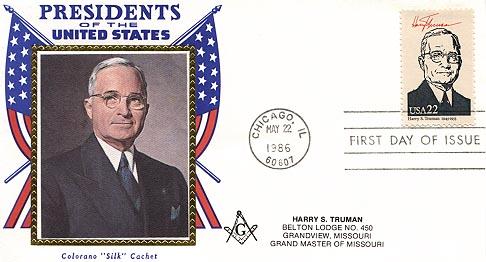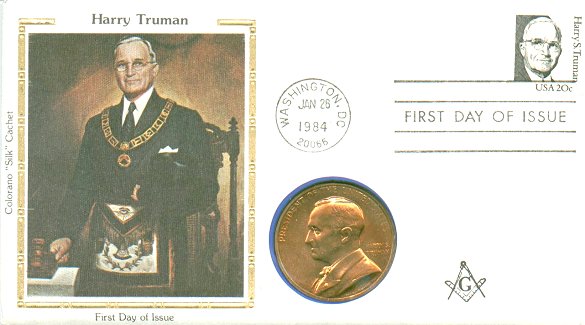Harry S
Truman
33rd
President of the United States

During his few weeks as Vice
President, Harry S Truman scarcely saw President Roosevelt, and received no
briefing on the development of the atomic bomb or the unfolding difficulties
with Soviet Russia. Suddenly these and a host of other wartime problems became
Truman's to solve when, on April 12, 1945, he became President. He told
reporters, "I felt like the moon, the stars, and all the planets had fallen on
me." Truman was born in Lamar, Missouri, in 1884. He grew up in
Independence, and for 12 years prospered as a Missouri farmer. He went
to France during World War I as a captain in the Field Artillery.
Returning, he married Elizabeth Virginia Wallace, and opened a haberdashery in
Kansas City. Active in the Democratic Party, Truman was elected a judge
of the Jackson County Court (an administrative position) in 1922. He
became a Senator in 1934. During World War II he headed the Senate war
investigating committee, checking into waste and corruption and saving perhaps
as much as 15 billion dollars. As President, Truman made some of the
most crucial decisions in history. Soon after V-E Day, the war against Japan
had reached its final stage. An urgent plea to Japan to surrender was
rejected. Truman, after consultations with his advisers, ordered atomic bombs
dropped on cities devoted to war work. Two were Hiroshima and Nagasaki.
Japanese surrender quickly followed. In June 1945 Truman witnessed the
signing of the charter of the United Nations, hopefully established to
preserve peace. Thus far, he had followed his predecessor's policies,
but he soon developed his own. He presented to Congress a 21-point program,
proposing the expansion of Social Security, a full-employment program, a
permanent Fair Employment Practices Act, and public housing and slum
clearance. The program, Truman wrote, "symbolizes for me my assumption of the
office of President in my own right." It became known as the Fair Deal.
Dangers and crises marked the foreign scene as Truman campaigned successfully
in 1948. In foreign affairs he was already providing his most effective
leadership. In 1947 as the Soviet Union pressured Turkey and, through
guerrillas, threatened to take over Greece, he asked Congress to aid the two
countries, enunciating the program that bears his name--the Truman Doctrine.
The Marshall Plan, named for his Secretary of State, stimulated spectacular
economic recovery in war-torn western Europe. When the Russians blockaded the
western sectors of Berlin in 1948, Truman created a massive airlift to supply
Berliners until the Russians backed down. Meanwhile, he was negotiating
a military alliance to protect Western nations, the North Atlantic Treaty
Organization, established in 1949. In June 1950, when the Communist
government of North Korea attacked South Korea, Truman conferred promptly with
his military advisers. There was, he wrote, "complete, almost unspoken
acceptance on the part of everyone that whatever had to be done to meet this
aggression had to be done. There was no suggestion from anyone that either the
United Nations or the United States could back away from it." A long,
discouraging struggle ensued as U.N. forces held a line above the old boundary
of South Korea. Truman kept the war a limited one, rather than risk a major
conflict with China and perhaps Russia. Deciding not to run again, he
retired to Independence; at age 88.

Masonic
History
Truman petitioned Belton Lodge
No. 450, Grandview, Mo. on December 21, 1908 when he was 24 years old.
He was elected on February 9, 1909, and received his first degree that
evening. He was passed March 9, and raised March 18, 1909. The
following year he accepted the station of Junior Warden, but in 1911, several
members of Belton Lodge separated to establish a new Lodge--Grandview Lodge
No. 618, and Truman was honored by being made the first Worshipful Master.
Later, he served as secretary of the Lodge, and in 1917, when leaving for WW
I, he was again Master of the Lodge. After the war he was appointed
district deputy grand lecturer, and district deputy grand master of the 59th
Masonic district. He remained in these stations from 1925 until his
appointment in the grand lodge line in 1930. In that year he became
grand pursuivant through the appointment of Grand Master William R. Gentry of
St. Louis. In September, 1940 when the grand lodge met, Truman was
running for U.S. Senator and the political situation was heated.
Notwithstanding, he was elected Grand Master, and a few weeks later, U.S.
Senator. During his year as Grand Master, Congress was in session most
of the time, yet he found time to make individual visits to 19 Missouri
Masonic Lodges; 6 district associations; both confrences of district deputies;
presented several 50-year pins; visited the Grand Lodge of Texas and District
of Colombia; attended an anniversary gathering of Philadelphia Lodge, and in
Jefferson City attended a Masonic dinner at which Gov. Forrest C. Donnell,
grand senior warden, was present and 128 Lodges were represented by 394 Master
Masons, including 80 members of the Missouri Legislature. Representing
Missouri at the Washington conference of Grand Masters in February 1941, he
presented Missouri's check for $1,900 to the Washington Memorial at
Alexandria. It was also during his year that the Missouri Lodge of
Research was established and both the dispensation and charter were signed by
him. Long interested in the Research Lodge, he served as its Master in
1950, while President of the United States. In this capacity he secured
the offices of the Library of Congress, and furnished the Research Lodge with
copies of the vast amount of reference cards on Freemasonry that are on file
in that institution. He again aided the Missouri Lodge of Research by
writing the forward for Volume 1 of 10,000 Famous Freemasons, published in
1957. While President, he was never too busy to go out of his way to
render a Masonic service. During this period he raised more than 30
candidates with the strict injunction that no publicity was to come from his
participation. His capitular degrees were received in Orient Chapter No.
102 of Kansas City on November 11 and 15, 1919; the cryptic degrees in
Shekinah Council No. 24, Kansas City on December 18, 1919; the orders of
knighthood in Palestine Commandery No. 17 of Independence on June 7 and 15,
1923. His Scottish Rite Degrees were received in Kansas City, January
24, March 27, 30 and 31, 1917. On October 19, 1945, he received the 33rd
Degree (SJ) at Washington D.C. while president. He became a member of
Ararat Shrine Temple, Kansas City, April 2, 1917. He was orator of that
body in 1932., marshal in 1933, and second ceremonial master in 1934. He
became a member of the Royal Order of Jesters, Kansas City Court No. 54 on
December 18, 1931. He was also a member of Mary Conclave, Red Cross of
Constantine, Kansas City. He was the grand representative of the Grand
Lodge of Scotland near the Grand Lodge of Missouri. Mrs. Truman, the
former Bess Wallace, is the daughter of David W. Wallace, who was Grand
Commander of the Grand Commandery, Knights Templar of Missouri in 1892.
His sister, Mary Jane Truman, is pasr grand matron of the Order of Eastern
Star of Missouri.
He died December 26, 1972,
after a stubborn fight for life.

